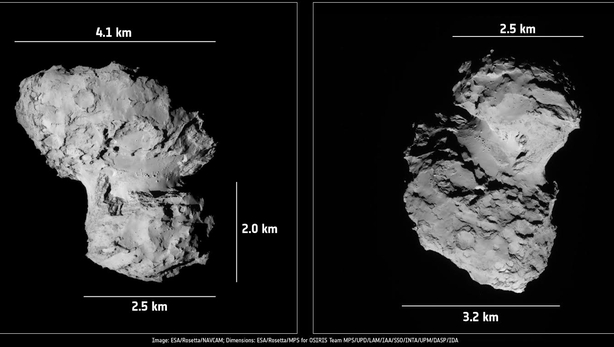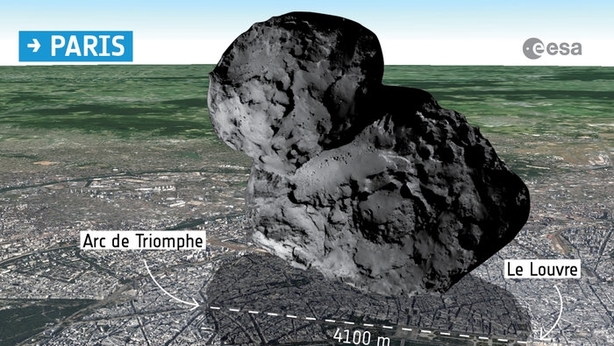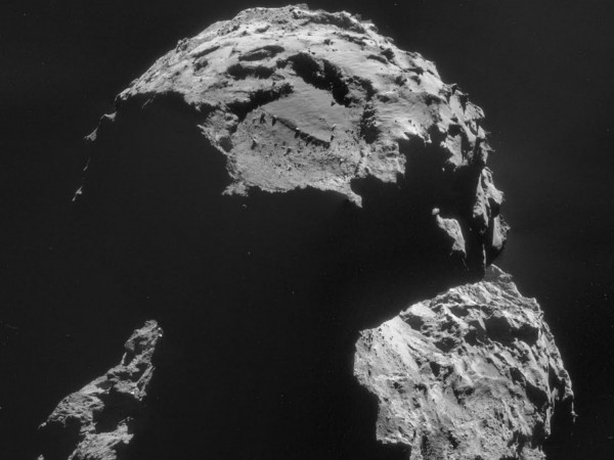By Will Goodbody, Science & Technology Correspondent
It is audacious, and if it works, it will be astounding. On Wednesday, mankind will hopefully achieve another first in space exploration and scientific endeavour, by dropping a small dishwasher sized probe onto a comet located 500 million kilometres away from Earth.
What is the Rosetta mission?
The Rosetta mission began ten years ago, with the launch of a space craft on an epic six billion kilometre journey to rendez-vous and land a probe on comet 67P/Churyumov-Gerasimenko. Travelling such a distance is no mean feat, so in order to pick up speed and power, it used a series of three passes around Earth and one around Mars between 2005 and 2009 as a gravitational sling shot to send it on its way. Then in May 2011, as it headed out into cold deep space away from the Sun, it was put into hibernation in order to conserve energy. 31 months later, in January of this year, it was woken back up again. But still 5.6 million miles from its destination, it continued on its journey and finally rendez-voused with the comet in August.

What is a comet, and what is this one like?
Comet 67P was discovered in 1969 by several astronomers in Kiev. Like all comets it is a big dirty snowball, believed to contain material that has changed little since the dawn of the solar system 4.6bn years ago. Many scientists believe comets may contain complex carbon molecules that helped seed life on Earth. And that they may have provided the original source of water on Earth, which of course is essential to life. This particular comet is a regular visitor to the inner solar system as it orbits the Sun every 6.5 years, between the orbits of Jupiter and Earth. Since it arrived at the comet last summer, Rosetta has been busy photographing, mapping and analysing the gas and particles being emitted by it. We know it is 4km wide, weighs ten billion tonnes, is travelling at 55,000km/h, rotates every 12 hours and 24 minutes, is the shape of a rubber duck and has the density of pine, meaning if it were dropped in water it would float. But there are also many unknowns, and in particular scientists are not entirely sure what its surface is like and how solid the crust is. That is a problem because if it is too soft, the lander could sink, and if it is too hard, it could bounce back into space as there is limited gravity on the comet's surface.
A picture comparing the comet with the city of Paris

What's the lander like?
The lander is a 100 kilogramme metal box full of electronics. It is called Philae after an island on the river Nile in Egypt where an inscribed obelisk was found that helped Egyptologists to break the code of the Rosetta stone. It measures a meter across, and its outer casing is covered in solar cells to capture energy from the sun. It has three legs, and two harpoons underneath to anchor it to the surface. Inside it is packed with ten different experiments and pieces of equipment to study the comet, including its magnetic field, temperature, radiation levels and composition. Sensors on its legs will test how the sound travels through the surface, while cameras will take panoramic and close up pictures. Philae has been built by a European consortium including the European Space Agency and institutes from Austria, Finland, France, Hungary, Ireland, Italy and the UK, all under the leadership of the German Aerospace Research Institute (DLR).
So where is the lander going to land?
Using data gathered by Rosetta during its three months of orbiting the comet, scientists chose a number of potential landing sites upon which to try to set Philae down. Landing site J was then chosen, later to be renamed as Agilka after another island on the Nile. Located on the "head" of the duck, it was chosen because it is relatively flat region on the comet's surface, which is covered in boulders (some the size of houses), jagged outcrops and steep cliffs. That means there is a high degree of risk attached to the landing, because if the probe lands on a boulder, and topples over, it is curtains for the mission.

It all sounds very exciting! What happens next?
The landing process has been under way for some time, with scientists carefully planning Rosetta's flight path to place it in the optimum position to drop the lander. Everything is critical at this point, but it gets really exciting from Tuesday evening onwards. That is because beginning at 7pm Irish time on Tuesday, there will be a series of five Go/No-Go points over the following 12 hours, where scientists at the European Space Agency can decide to postpone if they are not happy with the way things are shaping up. Assuming all five decisions get the green light, the probe will be released at around 8:35am on Wednesday, with confirmation coming 28 minutes 20 seconds later at 9:03am. Then, during a nail-biting seven hour drop, Philae will send back information about the dust and gas it encounters en route. Once it is on its way, there is nothing scientists can do to alter that descent. It should touch down around 15:30pm, but it will take 30 minutes for a confirmation signal to arrive back on Earth.
And once on the surface, what then?
Once it lands, Philae will fire the two harpoons and whirl ice screws in its legs into the surface to anchor itself in place. If it makes it down in once piece, it will immediately begin carrying out its scientific missions. It has a drill on board which can take samples from as deep as 23 centimetres below the surface. The samples can be heated and turned into gas for analysis on board the lander. All the time the comet it will be edging closer to the Sun, which it will be closest to in mid-July 2015. During that period Philae will witness how the comet changes while approaching the Sun, what gasses and how much water vapour it emits as it warms up. The comet should be passed the Sun by December 2015, by which time the mission ends.
How significant is all of this?
Very. The Rosetta mission has already scored as series of space and science firsts - its had two close encounters with an asteroid en route to the comet; it is the first spacecraft to orbit a comet's nucleus; it has gathered loads of never before captured pictures and data and it is the first time a craft has flown alongside a comet as it heads towards the inner solar system. And if Wednesday's activities end in success, it will become the first spacecraft to witness up close what happens to a comet as it gets warmed by the Sun, the first controlled touchdown of a lander on a comet nucleus and carry out the first in situ analysis of its composition.
What is Ireland's role in all of this?
First and foremost, Ireland is a member of the European Space Agency and so contributes financially to its efforts. Two Irish companies were involved in the building of the craft. Space Technology Ireland Ltd, led by Prof Susan McKenna Lawlor, designed the Electrical Support System (ESS) processor unit. When Philae is on the comet, this system will play a key role in passing the streams of commands and data between the Rosetta spacecraft and the instruments on the lander - making it "mission critical hardware". Prof McKenna Lawlor is also on the project steering committee and is involved in one of the experiments on board Philae. CAPTEC - a software development specialist company in Malahide - developed the Electronic Support System software for the Philae lander's interface with the satellite and also carried out validation and engineering support work on systems built by other companies. Meanwhile, Laurence O'Rourke from Killucan Co Westmeath, is ESA Lander System Engineer and one of two science operations coordinators for the project.
Click here to watch a video explaining the story of Rosetta so far.
Comments welcome via Twitter to @willgoodbody

